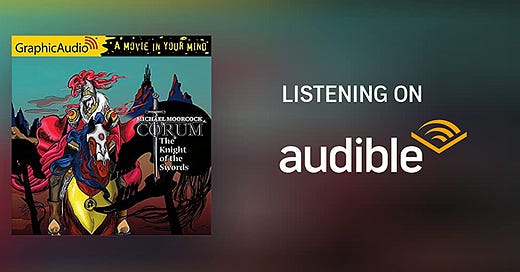Corum Jhaelen Irsei, the Prince in the Scarlet Robe, isn’t the first-published incarnation of Michael Moorcock’s Eternal Champion, but he may be the best way to enter Moorcock’s sprawling mythos. Like many first-time readers of Moorock, Corum begins The Swords Trilogy ignorant of his true nature—as well as that of his world and the Multiverse that contains it. This gives new readers a chance to discover these details along with the protagonist.
I chose to listen to the Graphic Audio version of The Knight of the Swords, found on Audible, which is an amazing dramatization. I highly recommend it to anyone who appreciates that type of presentation.
Synopsis
Corum is a Vadhagh, one of the many names Moorcock gives different versions of the elf-like race populating his Multiverse. The Vadhagh no longer believe in either sorcery or gods, but are masters science and philosophy. They also have the natural ability to both see into, and to move into, certain parallel planes of existence—an ability shared with their rival elder race, the Nadragh. By the time of the novel, this rivalry has mostly run its course. The Vadhagh and the Nadragh have been at peace for centuries. Both have long remained isolated in their own communities, absorbed in intellectual pursuits.
Meanwhile, a younger (and human) race known as the Mabden has risen to power. The more warlike of the Mabden have exterminated most of the Nadragh, enslaving the rest. Corum soon learns these Mabden are well on their way to destroying the Vadhagh as well—a task they all but accomplish when they burn his home and kill his family. In a rage, he attacks his enemies, killing several. Their leader, however—the evil and depraved Earl Glandyth-a-Krae—overpowers, tortures, and disfigures Corum.
Corum escapes and swears vengeance against all Mabden for the deaths of his family and the genocide of his race. In the course of his quest to heal his injuries and slay his nemesis Glandyth, he will learn his world is stranger than he had imagined—the Prince in the Scarlet Robe will come face-to-face with both the sorcery and the gods his people had thought were only superstition.
Influence on D&D
With the inclusion of The Knight of the Swords by title on Moldvay’s “Inspirational Source Material” list in the 1981 Dungeon & Dragons Basic Rulebook, and Moorcock by name both on that list and on Gary Gygax’s Appendix N in the 1979 AD&D Dungeon Master’s Guide, it’s unsurprising to find the seeds of core D&D concepts in the novel.
Alignment: In the last quarter of the book, Corum learns of the cosmic conflict between the philosophies of Chaos and Law, and the importance of the Balance in preserving mortals from the excesses of either.
Planes of Existence/The Multiverse: The reality of different universes, and whether they are ruled by the gods of Chaos or Law, is significant to the plot of The Knight of the Swords.
The Hand of Kwll and the Eye of Rhynn: These enchanted remnants of the two Lost Gods allow Corum to recover both the sight in his right eye, and the use of his left hand. They also provide him with sorcerous abilities to aid him in time of need—but at what cost? It’s difficult to read of these perilous “gifts” and not draw a direct connection to the Eye and Hand of Vecna in the Dungeon Master’s Guide. While their exact origins and descriptions diverge, it seems unlikely the similarities between these artifacts are the result of coincidence.
Inspiration for your Game
While the creators of D&D evidently mined The Knight of the Swords for what became key ideas, there is still plenty of material enterprising DMs can adapt.
Here are two suggestions—
Nadragh: Giving elves a rival race of equivalent age and power can add an interesting dimension to a D&D campaign—especially if it’s a playable race. D&D elves are well-versed in magic, and can only travel the planes by using it. A focus on science, and a limited special ability to plane-shift, could distinguish a Nadragh-type race, giving them their own niche in the game.
Ragha-de-Kheta: During his quest, Corum encounters a humanoid race with vestigial bird-like characteristics. While not inherently evil, the Ragha-de-Kheta are in thrall to the god of Chaos who rules Corum’s world. Intimidated by their patron, they refuse to resist his evil will, instead waiting for inevitable destruction at his hand, hoping their acquiescence will encourage him to let them live a while longer. This is an interesting philosophical outlook for a D&D race, and could prove a subtle challenge for player characters who may need to uncover this motivation to explain the puzzling decisions of NPC’s based on the Ragha-de-Kheta.
See Also
Source Material: The Queen of the Swords, by Michael Moorcock





Updated to include link to the post "Source Material: 'The Knight of the Swords' by Michael Moorcock".